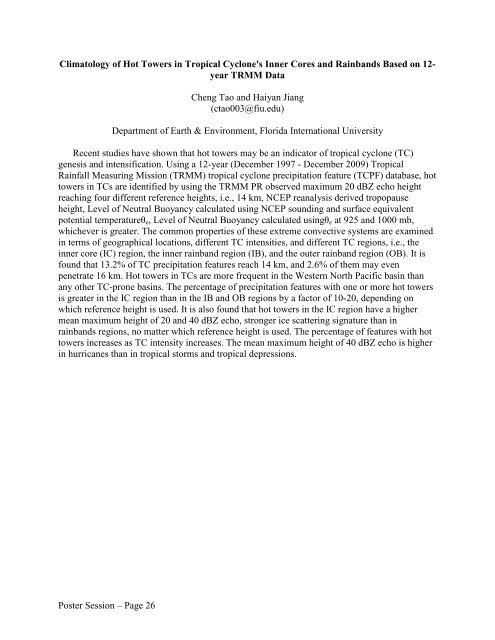65th IHC Booklet/Program (pdf - 4.9MB) - Office of the Federal ...
65th IHC Booklet/Program (pdf - 4.9MB) - Office of the Federal ...
65th IHC Booklet/Program (pdf - 4.9MB) - Office of the Federal ...
Create successful ePaper yourself
Turn your PDF publications into a flip-book with our unique Google optimized e-Paper software.
Climatology <strong>of</strong> Hot Towers in Tropical Cyclone's Inner Cores and Rainbands Based on 12-<br />
year TRMM Data<br />
Cheng Tao and Haiyan Jiang<br />
(ctao003@fiu.edu)<br />
Department <strong>of</strong> Earth & Environment, Florida International University<br />
Recent studies have shown that hot towers may be an indicator <strong>of</strong> tropical cyclone (TC)<br />
genesis and intensification. Using a 12-year (December 1997 - December 2009) Tropical<br />
Rainfall Measuring Mission (TRMM) tropical cyclone precipitation feature (TCPF) database, hot<br />
towers in TCs are identified by using <strong>the</strong> TRMM PR observed maximum 20 dBZ echo height<br />
reaching four different reference heights, i.e., 14 km, NCEP reanalysis derived tropopause<br />
height, Level <strong>of</strong> Neutral Buoyancy calculated using NCEP sounding and surface equivalent<br />
potential temperatureθ e , Level <strong>of</strong> Neutral Buoyancy calculated usingθ e at 925 and 1000 mb,<br />
whichever is greater. The common properties <strong>of</strong> <strong>the</strong>se extreme convective systems are examined<br />
in terms <strong>of</strong> geographical locations, different TC intensities, and different TC regions, i.e., <strong>the</strong><br />
inner core (IC) region, <strong>the</strong> inner rainband region (IB), and <strong>the</strong> outer rainband region (OB). It is<br />
found that 13.2% <strong>of</strong> TC precipitation features reach 14 km, and 2.6% <strong>of</strong> <strong>the</strong>m may even<br />
penetrate 16 km. Hot towers in TCs are more frequent in <strong>the</strong> Western North Pacific basin than<br />
any o<strong>the</strong>r TC-prone basins. The percentage <strong>of</strong> precipitation features with one or more hot towers<br />
is greater in <strong>the</strong> IC region than in <strong>the</strong> IB and OB regions by a factor <strong>of</strong> 10-20, depending on<br />
which reference height is used. It is also found that hot towers in <strong>the</strong> IC region have a higher<br />
mean maximum height <strong>of</strong> 20 and 40 dBZ echo, stronger ice scattering signature than in<br />
rainbands regions, no matter which reference height is used. The percentage <strong>of</strong> features with hot<br />
towers increases as TC intensity increases. The mean maximum height <strong>of</strong> 40 dBZ echo is higher<br />
in hurricanes than in tropical storms and tropical depressions.<br />
Poster Session – Page 26
















